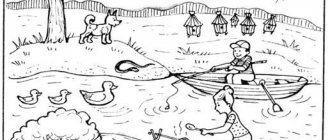What are frontal speech therapy classes?
On January 1, 2014, the Order “On approval of the federal educational standard for preschool education” came into force. The goal of the Federal State Educational Standard for Preschool Education is for preschoolers to receive a quality education. In accordance with this order, the goal of a speech therapist in a kindergarten is the timely identification of speech disorders and assistance in eliminating them.
Important! The new standards for preschool education are based on the principle that the child is also an individual. He is a subject of education and has the right to choose in the learning process.
The Federal State Educational Standard for Education identifies five educational sectors. Speech development - one of these branches - is directly related to speech therapy, the other four (social-communicative, cognitive, artistic-aesthetic and physical development) go in parallel with it.
Frontal speech therapy classes are a system that combines games, articulatory gymnastics, physical exercises and various speech therapy tasks of an oral and written nature. This is the preparatory stage of the transition from kindergarten to school. The tasks are given the same for all children in the group.
Important! Through games, children get acquainted with social norms, try on various roles, and model situations that interest them. In the game, the baby is not afraid to make a mistake, he is relaxed and behaves naturally.
At this time, the speech therapist should monitor the dynamics in speech development. A child may make a mistake and that’s normal, don’t rush him. He is just learning his native language, comparing his pronunciation and the pronunciation of adults.
Examples of frontal exercises
Conducting frontal speech therapy classes can be considered in the example below.
Frontal speech therapy session for children of senior preschool age with special needs development
Goal: teaching the difference between the sounds [T] and [T']
Task:
- teach the correct pronunciation of these sounds;
- develop teamwork skills;
- working out speech breathing;
- teach how to correctly identify the sounds [T] and [T'] in words;
- develop phonemic awareness;
- practice creating diminutive forms of words (shoe, hatchet, TV, etc.)
Preparation for the lesson: cut out pictures with the sounds [T] and [T']. The number of pictures should be equal to the number of children in the group. Place the chest on the table. Write the sounds [T] and [T'] on the board, glue a drawing of the letter T with a picture and a sound profile, prepare puzzles on the topic of the lesson, riddles, games. Prepare chips for correct answers. Divide the children into 2 teams. Explain that they will receive chips for correctly completed tasks. The winner will be the team that collects the most chips.
Important! Before conducting a lesson, a favorable psychological climate should be established. Decide in advance on the topic of the lesson and develop a plan.
- Exercise
The speech therapist asks the children: “Who do you think is hiding in my chest?” and shows a photo of his paws.
"What is this?" - asks the speech therapist.
“Paws,” the children answer.
“Now change the first letter in the word to “T”. What happened?".
"Slippers!" - the children answer.
The speech therapist takes slippers out of the chest.
After this, the teacher suggests calling the slippers affectionately (slippers, tapuli, slippers)
- Exercise
The speech therapist leads the children to a board on which the sound profile of the letter “T” is drawn.
And it shows what happens to the lips and tongue at the moment the sound is pronounced.
Articulatory profile of the sound T
- Exercise
The speech therapist asks the children to tell us what they know about the sound [T] (consonant, unvoiced, hard) and turn it into soft [T'] (Ть). Need to show the sound profile of the sound [T']
Articulatory profile of the sound T'
The speech therapist then asks you to show the letter T using your body and hands.
- Exercise
Speech therapist: “I have cards on my table with the sounds [T] and [T']. Whoever has a card with a hard sign sits at the right table, and whoever has a soft sign sits at the left table.”
- Exercise
Open lesson on speech development in the first junior group
Speech therapist: “Now come up with a name for your teams. On the right is a command with the sound [T], and on the left with the sound [T'].” Children confer and announce the names of their teams.
- Exercise
The speech therapist announces the next game. Children should stomp if they hear the sound [T] and clap if they hear [T'].
- Exercise
Speech breathing and voice strength training. The speech therapist asks to start the motor: TTTTTTTTTTTTT... - until the motor stalls.
- Exercise
Physical education minute.
- Exercise
The speech therapist says it's time to eat. And the children must name what they would eat with the sound [T] and [T'], respectively.
- Exercise
Stretch your fingers with finger exercises.
- Exercise
The speech therapist thanks the children for their work and counts who earned how many chips.
Important! The number of tasks may be more or less. Themes can be varied: New Year, autumn, spring. Depending on the tasks facing the speech therapist, puzzles and games may be modified.
The feasibility and advantages of frontal exercises over other types of exercises
Frontal speech therapy classes are conducted with all children in the group. They perform the same tasks in such classes. To prepare for frontal classes, children attend individual and subgroup classes. If, when conducting subgroup classes, most of the time is devoted to producing sounds for children with the same speech defects, then a frontal lesson is the next step.
Conducting frontal classes gives the speech therapist greater freedom of choice in setting the goals and content of the lesson. During these classes, sounds are reinforced, exercises are added to expand vocabulary, and grammatically correct speech is taught. Frontal classes are the basis of correctional education and preparing a child for school. They are carried out throughout the entire training period according to a specially developed plan. The undoubted advantage of this type of activity is that children have the opportunity to observe their peers. Social interaction occurs.
Frontal learning allows the entire group of children to work on a single task. Children cooperate with each other. The effectiveness of such training depends on the speech therapist’s ability to create an atmosphere of unified creative work and the importance of each participant in achieving the result. It is important to keep children attentive and active, while taking into account their individual characteristics.
Important! Frontal classes are the final stage in speech therapy training. Subgroup and individual lessons - preparation for frontal ones.





